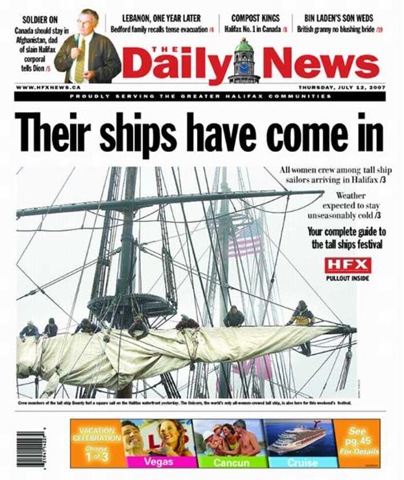[Demonstrating that unions are as clueless as ever, six unions that represent 600 employees at the Honolulu Advertiser are incensed at Gannett’s latest offer of a 1 percent increase in wages and a 1.5 percent bonus. Gannet is “doing great,” said Hawaii Rep. Neil Abercrombie, who evidently has not read Gannett’s latest earnings release or noticed that its stock is off 60% over the last three years. All the congressman wants is for Gannett to share some more of that bounty, since its future looks so bright. One is reminded of the UAW strikes in the 1970s, which were just what the US auto industry needed at the time. – Ed.]
[The editors at E&P should have read this story more carefully. It appears to contain good news for newspapers, but the numbers just don’t make sense. Tell me if you can untangle this:
According to new research, “the increase in the online newspaper audience is making up 28% of the losses in print readership.” Umm, what does that mean? Making up what? Circulation? Advertising revenue? It goes on to say that “from August 2004 through March 2007….online newspaper readership grew 14%.” Wow, that’s pretty pathetic, if you ask me. That would be an annual growth rate of less than 5%, which differs from all the other research that’s been done in this area. Finally, we learn that “70% of all newspaper web site visitors also read the print version.” It that’s true, it’s bad news. It indicates that newspaper Web sites are attracting mostly their own print subscribers. – Ed.]
‘Baltimore Sun’ Launches Youth-Oriented ‘b’ – MediaPost, Feb. 21, 2008
The Baltimore Sun is planning to launch a new free tabloid targeting younger readers called “b.” The first daily issue is set to appear on April 14. With a mix of typical tabloid fare and lifestyle content, the newspaper plans to freshen its pages by inviting readers to submit their own stories, photos and video to the newspaper and its Web site.
They appear to be doing something right at Lee Enterprises. Quoting: “[T]he reach of Lee’s print and online newspapers between October 2006 and October 2007 increased to 71% of all adults inits markets from 67%. And while the percentage of adults who read only the print newspaper remained steady at 50%, the percentage who read both print and online editions grew to 16% from 11%… Lee advertising revenue declined 1.4% in the fourth quarter of fiscal 2007, compared with an industry average decline of 7.4%.”
Help wanted. Desperately. – Reflections of a Newsosaur, Feb. 10, 2008
[Alan Mutter analyzes the crash of the newspaper help-wanted market, which he figures has contracted 54% in the last seven years. He traces the beginning of the end to 9/11 and cites newspaper smugness over their once near-monopoly on that business. Newspapers failed to understand that readers weren’t going to go to a single destination to find jobs. Increasingly, they want the jobs to find them. Unless newspapers understand that and act quickly, he says, they’re going to lose the half of the market that hasn’t slipped away yet. -Ed.]
 The Albuquerque Tribune, a newspaper that won a Pulitzer Prize as recently as 1994, will publish its last issue on Saturday. Circulation at the afternoon daily had dwindled from 42,000 in 1988 to just 10,000. Owner EW Scripps Co. had put the paper up for sale last August, but the only serious bidder wasn’t able to close the deal and no other interested parties emerged. Editor Phil Casaus said the last three editions will feature stories about The Tribune’s role in Albuquerque journalism. The 38 editorial staffers were informed this morning.
The Albuquerque Tribune, a newspaper that won a Pulitzer Prize as recently as 1994, will publish its last issue on Saturday. Circulation at the afternoon daily had dwindled from 42,000 in 1988 to just 10,000. Owner EW Scripps Co. had put the paper up for sale last August, but the only serious bidder wasn’t able to close the deal and no other interested parties emerged. Editor Phil Casaus said the last three editions will feature stories about The Tribune’s role in Albuquerque journalism. The 38 editorial staffers were informed this morning.


